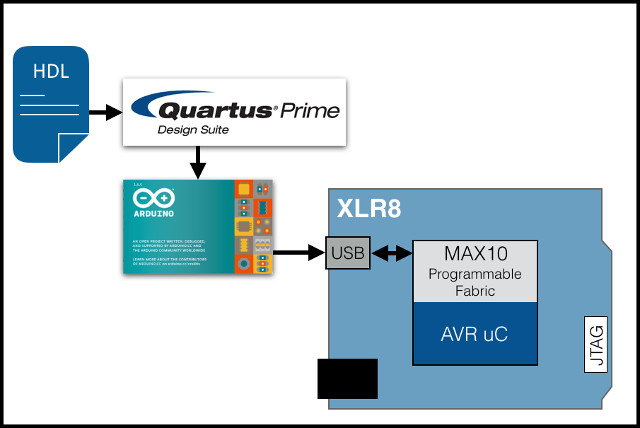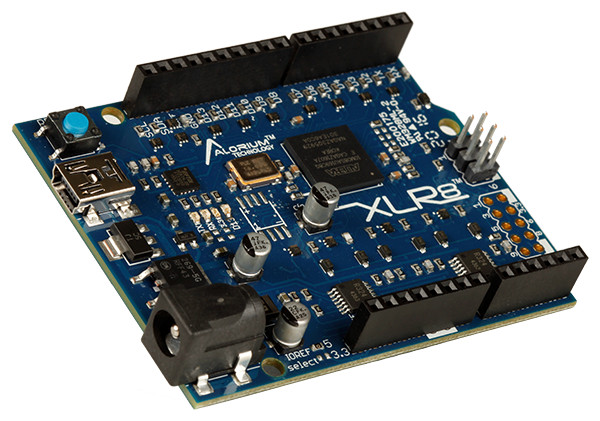We already have a fair choice of boards with Arduino compatible headers powered by an FPGA with options such as $99 Digilent Arty (Xilinx Artix-7 FPGA), FleaFPGA (Lattice FPGA), Papillio DUO (Xilinx Spartan 6), or Snickerdoodle + shieldBuddy (Xilinx Zynq-7010/20). There’s no yet another choice with Alorium Technology XLR8 Arduino UNO like board powered by Altera MAX10 FPGA.
XLR8 board specifications:
- FPGA – Altera MAX 10 FPGA
- MCU – Atmel/Microchip ATmega328 8-bit MCU
- Digital I/Os
- 5V inputs, 3.3V outputs
- 14x Digital I/O Pins
- 6x PWM Digital I/O Pins
- 6x Analog Pins
- Analog Inputs
- 5V tolerant
- Op-amp circuit emulates 0-5V behavior of the ADCs on the Arduino UNO
- Performance: 1 MHz;
- Resolution: 12-bit sustained
- Sample Rate: 154k samples/second
- Power Supply – 5V via USB or barrel connector
- Dimensions – Arduino UNO form factor
The board is supported by Altera Quartus Prime Lite Edition, and programmable either via JTAG though a USB blaster, or USB with OpenXLR8 and Arduino IDE without additional hardware as shown in the diagram below.

The FPGA can be programmed with what the company called Xcelerator Blocks (XB), an optimized hardware implementation of a specific processor intensive function, with functions such as Floating-point math, servo control, or NeoPixel shields, strips, and arrays control currently available. Future implementations likely to be worked on include: Proportional-Integral-Derivative (PID) control, event counters and timers, quadrature encoders/decoders, PWM, multiple UARTs, and enhanced Analog-to-Digital (ADC) functionality.
Alorium XLR8 board can be purchased on Mouser for $75. More details, including a wiki, a user forum, videos, and various getting started resources are available on Alorium Technology website.
Thanks to Nanik for the tip

Jean-Luc started CNX Software in 2010 as a part-time endeavor, before quitting his job as a software engineering manager, and starting to write daily news, and reviews full time later in 2011.
Support CNX Software! Donate via cryptocurrencies, become a Patron on Patreon, or purchase goods on Amazon or Aliexpress






Heavily Windows dependant, no simulation or synthesis in Linux (I don’t care about OSX). So as it is, this is just a fast(er) Arduino Uno for $75. A Quartus FPGA with an AVR core. As for their X-Blocks, the concept is interesting, but there are very few of them right now and no real promise of more. The problem with all these FPGA boards is that there’s no real tutorial to get a community productive and they all rely on either the Altera or Xilinx tools which are user hostile and very bloated.
@Drone
They have a Linux setup guide @ http://www.aloriumtech.com/wp-content/uploads/2016/09/XLR8LinuxSetup.pdf and Altera software is also available for Linux @ http://dl.altera.com/?edition=lite
I have not looked into the details, so it’s possible there are more feature implemented in Windows.
@Jean-Luc Aufranc (CNXSoft) The Linux setup guide is lame, just a front end requiring Python & pySerial. No simulation or synthesis in Linux: http://www.aloriumtech.com/openxlr8/ “Note: Simulation is currently only available on Microsoft Windows. Linux is coming soon. It is not available on Mac OS.” “Note: Synthesis is only available on Microsoft Windows and Linux (Linux untested). It is not available on Mac OS.” I consider a statement like “Linux untested” in the same sentence implying it is available in Linux to be nothing more than Clinton-esque bullsh*t. I have had nightmares getting Qartus to behave when native in Linux (Mint… Read more »